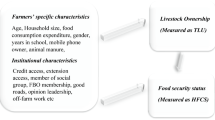Abstract
Livestock fulfill different functions. Depending on their livelihood strategies, households differ in their choice of what type of animal to keep and on accumulation of the chosen animal overtime. Using a panel data of 385 rural households in a mixed farming system in northern Ethiopia, this paper investigates the dynamic behavior of rural households’ livestock holding to identify determinants of choice and accumulation of livestock overtime. Choice is analyzed for a principal animal, the animal that constituted the largest value of livestock assets a household possessed, using a multinomial logit model. Results indicate that rural households differ in their choice of what type of animal to keep. Agro-climatic conditions, sex and age of household head, presence of an adult male member in a household, and liquidity are the major factors that influence the type of principal animal households keep. Conditional on the principal animal selected, we analyzed the factors that determine the accumulation of the chosen animals by correcting for selection bias. Area of land cultivated is the most significant factor that explains the number of animals households keep. Other factors include sex of household head, diversification into nonfarm self-employment, and shocks.
Similar content being viewed by others
References
Baldwin, K. L., De Veau, V., Foster, K., Marshall, M., 2008. Traits affecting household livestock marketing decisions in rural Kenya. Selected paper prepared for presentation at the American Agricultural Economics Association Annual Meeting. Orlando, FL. July 27–29.
Barrett, C.B., Bellemare, M.F., Osterloh, S.M., 2006. Household-level livestock marketing behavior among Northern Kenyan and Southern Ethiopian Pastoralists. In: J.G. McPeak and P.D. Little (eds), Pastoral livestock marketing in eastern Africa: Research policy challenges (Intermediate Technology Publications Ltd., London), 15–38.
BoANRD (Bureau of Agriculture and Natural Resource Development), 1997. Tigray Livestock Development Action Program: Executive Summary, Volume II. Mekelle. Tigray, Ethiopia.
Bourguignon, F., Fournier, M., Gurgand, M., 2007. Selection bias corrections based on the multinomial logit model: Monte Carlo comparisons, Journal of Economic Surveys 21(1), 174–205.
CSA (Central Statistical Agency of Ethiopia), 2007. The 2007 national statistics, Addis Ababa, Ethiopia.
Davies, J., Bennet, R. 2007. Livelihood adaptation to risk: Constraints and opportunities for pastoral development in Ethiopia’s Afar region, Journal of Development Studies, 43 (3), 490–511.
De Vries, D.H., Leslie, P.W., McCabe, J.T., 2006, Livestock acquisitions dynamics in nomadic pastoralist herd demography: A case study among Ngisonyoka herders of south Turkana, Kenya, Human Ecology, 34 (1), 1–25.
Dubin J.A., McFadden, D.L., 1984. An econometric analysis of residential electric appliance holdings and consumption, Econometrica 52(2), 345–362.
Fitsum H., Pender, J., Nega G., 2002. Land degradation and strategies for sustainable land management in the Ethiopian highlands: Tigray region (second edition), Socioeconomic and Policy Research Working Paper 25, ILRI (International Livestock Research Institute), Nairobi, Kenya.
Halderman, M., 2004. The political economy of pro-poor livestock policy-making in Ethiopia, Pro-Poor Livestock Policy Initiative, Food and Agricultural Organization (FAO), PPLPI Working Paper No. 19.
IFAD (International Fund for Agricultural Development), 2004. Livestock services and the poor: A global initiative, (Ugo Quintily S.P.A., Rome).
Johannesen, A.B., Skonhoft, A., 2011. Livestock as insurance and social status: Evidence from reindeer herding in Norway, Environmental Resource Economics, 48(4), 679–694.
Mahmoud, H.A., 2008. Risky trade, resilient traders: Trust and livestock marketing in northern Kenya, Africa: The Journal of the International African Institute, 78 (4), 561–581.
McFadden, D.L., 1973. Conditional logit analysis of qualitative choice behavior. In: P. Zarembka (ed), Frontiers in Econometrics (Academic Press, New York), 105–142.
Mutenje, M.J., Mapiye, C., Mavunganidze, Z., Mwale, M., Muringai, V., Katsinde, C.S., Gavumende I., 2008. Livestock as a buffer against HIV and AIDS income shocks in the rural households of Zimbabwe, Development Southern Africa, 25(1), 75–82
Næss, M.W., Bårdsen, B.J., 2010. Environmental stochasticity and long-term livestock viability—herd accumulation as a risk reducing strategy, Human Ecology, 38, 3–17.
Pavanello, S., 2010. Livestock marketing in Kenya–Ethiopia border areas: A baseline study, Humanitarian Policy Group (HPG) working paper.
Rogg, C., 2006. Asset portfolios in Africa: Evidence from rural Ethiopia, UNU-WIDER, Research Paper No. 145.
Sharp, K., Devereux, S., Yared, A., 2003. Destitution in the Northern Highlands (Amhara National Regional State), final report prepared for the Institute of Development Studies, Sussex and Save the Children UK, Addis Ababa.
Train, K.E., 2003. Discrete choice methods with simulation (Cambridge University Press, New York).
UNECA (United Nations Economic Commission for Africa), 1997. Livestock development in Tigray: Forage development strategy as a major entry point towards a sustainable minimum grazing system, Part I, Sustainable Development and Environmental Rehabilitation Program (SAERP): UNECA, Addis Ababa.
Woldehanna, T., Oskam, A., 2001. Income diversification and entry barriers: Evidence from the Tigray region of northern Ethiopia, Food Policy 26(4), 351–65.
World Bank, 2007. Agriculture for development, World Development Report 2008, Washignton, DC.
Zezza, A., Winters, P., Davis, B., Carletto, G., Covarrubias, K., Quinones, E., Stamoulis, K., Kafakis, T., Tasciotti, H., DiGiuseppe, S., Bonomi, G., 2007. Rural household access to assets and agrarian institutions: A cross country comparison, ESA Working Paper no. 07–177.
Acknowledgments
The authors are grateful to the Flemish Interuniversity Council (VLIR) for funding the research that has been carried out in the framework of the VLIR Institutional Cooperation Programme with Mekelle University.
Author information
Authors and Affiliations
Corresponding author
Rights and permissions
About this article
Cite this article
Tegebu, F.N., Mathijs, E., Deckers, J. et al. Rural livestock asset portfolio in northern Ethiopia: a microeconomic analysis of choice and accumulation. Trop Anim Health Prod 44, 133–144 (2012). https://doi.org/10.1007/s11250-011-9900-7
Accepted:
Published:
Issue Date:
DOI: https://doi.org/10.1007/s11250-011-9900-7




